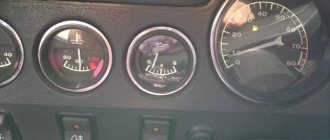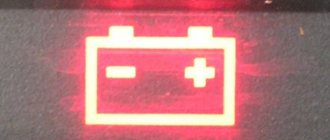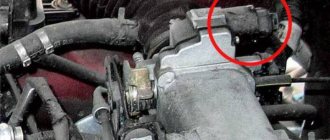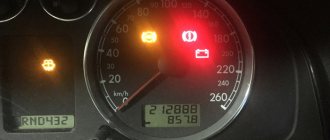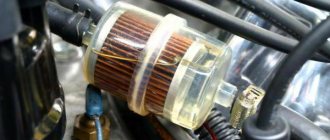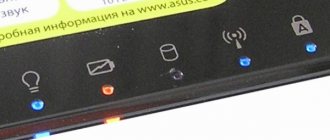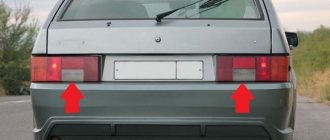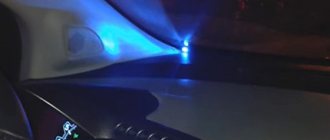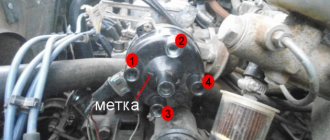As you know, the injection engine has replaced the carburetor engine mainly due to its efficiency, as well as the reduced amount of harmful emissions into the atmosphere. This became possible as a result of flexible adjustment of the operation of the internal combustion engine using the electronic control system of the ECM.
Note that the indicated “check” lights up for various reasons. In this article we will talk about why the check light blinks, the engine stalls, or the power unit is unstable in different modes, and such operation is accompanied by a lit internal combustion engine fault indicator.
Check on Solaris: blinking or on, reasons, what to do
The Solaris engine check light is on when the system begins to work incorrectly. Possible causes include insufficient tightening of the gas tank cap or engine failure. You need to check different parts of the working system, then promptly take action. If you can’t resolve the issue on your own, contact a service station. The risks of incorrectly lighting up checks will be reduced significantly if scheduled maintenance is carried out in a timely manner. You cannot ignore the signals, otherwise the problem will only get worse over time.
Replacing spark plugs and high-voltage wires
Spark plugs in a car are the main components for igniting the fuel mixture. If the spark plugs are faulty, the spark will not be supplied correctly to ignite the gasoline mixture. Faulty spark plugs often result in a lack of spark or an incorrect spark interval, which results in the engine not running properly. If the spark plugs do not work properly during acceleration, especially from a standstill, you may feel slight jolts.
What are the reasons for spark plug failure: Most spark plugs in cars produced before 1996 need to be changed every 25,000-30,000 kilometers. In newer cars, spark plugs last more than 150,000 km. However, these scheduled spark plug replacement intervals may be reduced by various factors related to fuel quality and driving style.
What needs to be done: If your spark plugs have not been changed for a long time, or you feel failures in the engine operation associated with ignition, then you must immediately replace them with new ones without delay. Do not try to save money by untimely replacement of spark plugs, since the cost of spark plugs is not very expensive, as well as the work of replacing them.
By replacing old spark plugs, you will improve engine performance and reduce your vehicle's fuel consumption. Changing spark plugs yourself is quite easy. Basically, they are easily accessible under the hood of the car. You need a regular spark plug wrench to remove the spark plugs from the engine.
It is also advisable to monitor the condition of high-voltage wires, since over time they can become unusable and allow electricity to pass through, which is transferred to the spark plugs, which will reduce the strength of the spark. Remember that regularly replacing spark plugs, in accordance with your car’s maintenance schedule, protects your exhaust catalyst from breakdowns and also improves engine performance!
This article was originally published in 2013 and updated with new information on 02/17/2020.
Diagnosing errors on Hyundai Solaris
If the CHECK light comes on when you start the engine, then there is no need to worry. But if the check light is on when the engine has already started, then you need to find out the cause of the error.
The vehicle owner may need to diagnose and remove errors that occur on the Hyundai Solaris in various situations when there is no desire to do this work in a certified service center.
It is not difficult to do this work, the main thing is to know that you can delete errors related to the first level , that is, those that are not recorded in the ECU memory and do not significantly affect the operation of the car and its devices. Because only a special dealer device (scanner - approx.) can remove such errors, one of such errors includes the error of the car's airbags.
When do you delete errors yourself?
Among all the important problems with the Hyundai Solaris, some can reset themselves after one or another repair.
For example, error codes from 301 to 304 , indicating a missed spark in one of the cylinders (the last error digit refers specifically to the cylinder - approx.).
If the error indicates a misfire in the cylinder, the first thing to look at is the condition of the spark plug. In the photo the candle is the culprit of this error.
Accordingly, when these gaps are detected, the ECU will give a signal in the form of a burning “CHECK”, which cannot be removed either by erasing the code or by resetting the terminal from the battery.
This error can be completely removed only by replacing the non-working spark plug with a new one, after which the error will disappear by itself.
Checking the oil level and condition
The next most important reasons for the signal are considered to be overheating of the motor and a decrease in the level of lubricating fluid in the internal combustion engine. It is recommended to check the engine temperature. If there is no overheating, you need to check the volume and condition of the oil. After checking the level, it is necessary to add the missing amount of lubricant. Using a clean paper napkin, the quality and composition of the engine oil is checked according to the following criteria:
- Color.
- Consistency.
- Presence of mechanical inclusions.
- The smell of burning.
If everything is in order with the quality and quantity of oil, the engine starts to eliminate unusual sounds and noise when operating both at idle and under load.
If unusual noise effects of a running engine are detected against the background of a burning check, it is recommended to send the car to the nearest service company. Moving the car yourself is not recommended; delivery is carried out by towing or other convenient method. Further operation can lead to serious damage and costly repairs to the elements of the power unit.
What does the icon on the Solaris dashboard mean?
Regardless of the year of manufacture, 2011, 2013 or 2022, the indication and appearance of the indicators are practically the same. Cars with a new body are equipped with standard instrumentation and all the bulbs, except for the ones added, will be identical. Globally, icons are divided into three types:
- index;
- warning;
- prohibiting movement.
The group breakdown looks like this.
- Notify the driver about the normal operation of standard systems.
- Warns the driver about problems that require intervention. This could be the activation of the TPMS system, the end of the fluid in the windshield washer reservoir, and others.
- When such icons flash, you must immediately stop the machine and fix the problem. Driving with a light on, such as check the engine or critical overheating of antifreeze, is strictly prohibited.
A few words about how the battery-generator tandem works
In order to prevent the above described, a small relay-regulator is installed in the rotor excitation circuit, the task of which is to reduce the current to the optimal level, regardless of the engine speed. As a result, the voltage is maintained at the required level. The battery light comes on when there is no charging from the generator.
- Faulty relay-regulator, diode bridge;
- Poor tension of the generator belt, critical wear or belt slippage. Wear (play) of the generator bearing;
- Blown fuse or poor contact;
- Poor contact at the battery terminals, at the generator terminal or at the ground wire;
- Open circuit of the generator excitation circuit, serious wear of the generator brushes or brush holders;
- Wearing out the ignition switch is an option, but in this case several lights will light up at once.
If the battery light is on while the engine is running, do not turn it off, open the hood and check the voltage at the battery terminals. If charging is supplied to the multimeter, the voltage should be 13.5-14.3V. If there is no charging, the voltage will be much lower - approximately 12V.
- Two screwdrivers (flat and Phillips);
- “Control” (12V light bulb);
- Multimeter;
- Pliers, a knife and sandpaper to clean the contacts.
Treatment: We strip the high voltage terminals and wires, after which we measure the voltage again. If this does not lead to anything, check the voltage at the “30” terminal of the generator. Connect one electrode of the multimeter to the generator terminal, the second to ground.
- In addition, the cause of the above situation may be a breakdown of one of the diodes or a break in the stator winding. Do the following - turn off the ignition, then check the diodes with a multimeter; if a breakdown is detected, replace them.
- It would be a good idea to check the generator brushes. To do this, simply remove the brushes and check their length, if the length is less than five mm. I recommend replacing the generator brushes.
- Situation four - after turning the key there is no charging, but all devices are functioning, the battery light does not light up.
- The reason may also be poor contact in the connector. It is necessary to clean everything properly and check the result; if it is not there, it is very possible that the lamp has burned out. If the problem is not in the light bulb (it burns dimly or intermittently), then other indicators will also light dimly or intermittently; if this only happens with the battery indicator, then perhaps the reason is in the light bulb itself.
Error code: Diagnostic equipment :: Scanners by brand :: BMW - DIAG2CAR.RU - diagnostic equipment for all brands of cars
After all the above checks, check the relay regulator, apply voltage to its contacts. Check the voltage on the brushes, if it is 12V, the relay is working properly. Otherwise, replace the relay regulator.
The process of diagnosing and resetting errors without OBD-II
On the Hyundai Solaris, you can diagnose and remove errors, even without having any additional devices at hand.
Diagnostics (this method does not work)
The method described below is circulating all over the Internet. We checked on our editorial machine. He does not work. We do not remove the method, as some owners may think that it works.
Refutation on video:
- We turn on the ignition, but do not start the engine - count 3 seconds.
- Next, squeeze the gas to the end 5 times in a row, and after the fifth, sharply release the pedal.
We press the gas pedal as written in the algorithm.
- We wait 7 seconds, and again press the pedal fully once.
- After this, the indicator on the instrument panel should flash.
- Let's release the pedal and look at the instrument panel and the trouble code.
- To exit the menu, turn off the ignition.
Answers (4)
We need to do a diagnosis. I had a similar experience on a Skoda, and then the car stopped starting altogether, replaced the spark plugs and everything is fine.
you need to scan the error codes, as there can be many possible faults
Two days ago I changed the oil and filters (oil, air, cabin). The condition of both the remaining oil and the filters was terrible (after the last change it drove exactly 10,000 km). I also replaced the pads. I bought spark plugs, but didn’t have time to replace them. I drove normally for two days, today the check started flashing again.
Amina, what kind of oil do you fill in, if on a new car, after 10,000 km it becomes “killed in the trash”. You need to take flushing oil and buy branded oil from the officials, since I strongly suspect that you are being bred with oil somewhere
To be honest, I don't remember the name. The previous oil was changed at the Hyundai Center, where I bought the car. They said it was branded, etc. This time my brother bought the oil. Again, I don’t remember the name (although it would be worth asking other masters about the quality of the oil I was buying), but my brother was told that the oil was branded and was suitable exactly, either for this car, or for this type of car. And so, the master said that we have low-quality gasoline here in Chechnya and because of this everything deteriorates and wears out quickly. I'm pouring 95
IT’S CLEAR that you won’t buy any other gasoline if it’s on sale, but try to get the oil from the service center where you bought the car, it’s very important what kind of oil the engine runs on. And if finances allow, then change it at least more often, somewhere around 7-8 thousand. Engine oil is like blood for us, as long as it is normal, then a person lives without problems, so does the engine.
Thank you, Sergey, I will definitely use your advice))
Good evening! I have the same problem again, I was driving home from work this evening and the check light came on again. The engine was not running. Last night I filled up with gas, I always fill in 95. I think maybe it’s because of this?! Both that time and this time the check started flashing on the second day after refueling. Tomorrow I'll try to go for diagnostics. I’m just worried about all this, I don’t have patience until tomorrow, I’m looking for answers on the internet
Amina, good evening! Maybe you’ve already solved your problem (I lost internet) it’s just that the check won’t light up because of nothing, and repairs are now expensive, so don’t delay diagnostics
Good afternoon I had the same problem with the check, the engine was tripping. We changed the spark plugs, and the diagnostics showed that the ignition coil had burned out - they changed it, everything is fine.
Step 1 - take out the spark plugs, if one is black, the rest are normal - the problem is probably in the coil, which is located above the spark plug, but you need to double-check. Replace this spark plug with any clean one, not necessarily a new one. After the car has cooled down (not necessary) or the next day, start it and wait a few minutes.
If the check light comes on, or 15 minutes have passed, remove the spark plugs again. If your clean spark plug is black again in the same place, then go to the store and buy an ignition coil. Costs from 700 to 2000 rubles. Even a girl can change everything on her own. And you change it. That's it, but if everyone is black, then other problems are possible.
Before checking the ignition system, place the manual transmission shift lever in the neutral position (automatic transmission selector lever in the “P” position) and apply the parking brake.
1. Open the hood.
2. Remove the four mounting bolts and remove the spark plug well cover.
3. With the ignition off, check the tightness of the ignition coils and wiring harness blocks.
4. If the ignition coil low voltage circuit fasteners are intact, check for spark at the spark plugs. Remove the ignition coil from any spark plug.
5. Insert a spare spark plug into the tip of the coil, press the metal part of the spark plug against the ground of the car. Have an assistant turn the engine crankshaft with the starter.
WARNING:
Reliable contact of the spark plug body with ground is mandatory, since if an additional spark gap appears, larger than the gap between the spark plug electrodes, damage to the ignition coil is possible.
Carry out this check for no more than five seconds so as not to damage the exhaust gas converter if gasoline that has not burned in the engine cylinders gets into it.
Note:
Inspect the surface of the ignition coil tip for insulator breakdown. The breakdown sites are highlighted in the form of characteristic black dots or “worms”. If any breakdown of the insulator is detected, the coil must be replaced.
Ignition coil tip.
6. If there is no spark, replace the ignition coil with a new one, as described here, after first trying to install proven spark plugs from the “working” machine.
As you know, the injection engine has replaced the carburetor engine mainly due to its efficiency, as well as the reduced amount of harmful emissions into the atmosphere. This became possible as a result of flexible adjustment of the operation of the internal combustion engine using the electronic control system of the ECM.
Note that the indicated “check” lights up for various reasons. In this article we will talk about why the check light blinks, the engine stalls, or the power unit is unstable in different modes, and such operation is accompanied by a lit internal combustion engine fault indicator.
Diagnosing errors on Hyundai Solaris
If the CHECK light comes on when you start the engine, then there is no need to worry. But if the check light is on when the engine has already started, then you need to find out the cause of the error.
The vehicle owner may need to diagnose and remove errors that occur on the Hyundai Solaris in various situations when there is no desire to do this work in a certified service center.
It is not difficult to do this work, the main thing is to know that you can delete errors related to the first level , that is, those that are not recorded in the ECU memory and do not significantly affect the operation of the car and its devices. Because only a special dealer device (scanner - approx.) can remove such errors, one of such errors includes the error of the car's airbags.
When do you delete errors yourself?
Among all the important problems with the Hyundai Solaris, some can reset themselves after one or another repair.
For example, error codes from 301 to 304 , indicating a missed spark in one of the cylinders (the last error digit refers specifically to the cylinder - approx.).
Signs of main malfunctions and reasons for the appearance of the indicator signal
If the Engine check light comes on while your car is moving after refueling at a gas station, the most likely cause is inappropriate quality of the gasoline poured in. The following symptoms are observed:
- Reduced power.
- Interruptions in engine operation (stalls).
- Detonation as a result of incomplete combustion of fuel.
To correct the situation, it is recommended to do the following:
- add a portion of higher quality fuel to the tank;
- Drain the recently filled gasoline and clean the fuel system.
If the check does not want to go out after the cause has been eliminated, you need to delete the error recorded in the device’s memory using a special computer program.
What does the Check Engine Light mean?
The name of the Check engine indicator literally translates as “Check engine”. However, when the light comes on or blinks, the engine may have absolutely nothing to do with it. A lit indicator may indicate problems in the fuel supply system, failure of individual ignition elements, etc.
Sometimes it can be a very minor problem - for example, a loose gas cap or a faulty catalyst. However, you should not ignore the indicator signals under any circumstances, as this can result in serious problems.
Sometimes the cause of the indicator light may be poor fuel quality. So don’t be surprised if, after refueling at an unfamiliar gas station, you see the Check Engine light flashing.
Typically the indicator is located on the car's dashboard under the engine speed indicator. It is indicated by a schematic engine or a rectangle with the inscription Check engine or simply Check. In some cases, instead of an inscription, a lightning symbol is depicted.
Is it possible to continue driving while the light is on?
The brake pads are worn out, it's time for the next maintenance, the speed is switched incorrectly, low-quality fuel is used, the on-board voltage has dropped - all this can cause the Check indicator to light up. First of all, you should check the motor. If the reason for the signal to turn on is due to engine malfunctions, it is dangerous to continue driving.
The problem is aggravated by the fact that it is impossible to independently determine the malfunction of a modern internal combustion engine by smell or color. You should contact professionals who will use a scanner to identify the malfunction, if, of course, there is one.
A burning Check light may indicate various breakdowns - it is better not to ignore it
Therefore, if after restarting the car the light does not go out, you can only drive it to the nearest car service center. There they will conduct a comprehensive diagnostic of the engine and its systems.
Operating a vehicle with the Check Engine icon illuminated leads to increased fuel consumption, unstable engine operation, and decreased traction characteristics of the vehicle. Moreover, in this case, the car owner may lose the guarantee for car repairs.
Why did the light come on and how to fix it
The main situations in which the indicator lights up and the recommended courses of action for the car owner:
- If the Check engine lights up and goes out immediately when starting the car, there is no damage to the engine. The cause of the fire is most likely harmless - the fuel tank cap is lost or not screwed in properly. Just wrap it tightly and check if the warning disappears.
- If the indicator lights up while driving, you should stop and check the wires. You may find a cable hanging loose under the hood or an open battery terminal. This applies to all attachments - wires, hoses, etc.
- If the light flashes while driving, you should stop and check the sounds made by the engine, pay attention to the oil level, and inspect the sides of the engine. If no visually obvious violations are detected, it is recommended to drive to the nearest car service center and carry out diagnostics.
- If the engine is running normally and the Check light is constantly flashing, there is most likely an ignition failure. You should check the spark plugs and coil, pay attention to the quality of the fuel. To do this, it is better to contact the nearest auto diagnostic center.
- If the indicator is constantly on, you need to stop, unscrew the spark plugs and check the gap. Gaps that exceed 1.3 may cause the light bulb to burn out.
- In addition, when the “check” is on, the ignition is usually checked. Any car service center has special testers that allow you to determine the wear of wiring insulation.
- A faulty fuel pump can also cause the light to come on. You should stop and listen to the sounds the fuel pump makes. A smooth hum without clicks or pauses is considered normal. If extraneous sounds appear, the pump should be dismantled, washed inside and the filter cleaned.
- Serious engine malfunctions can be indicated by the coolant temperature. If it is above 85–90 degrees, and the Check engine lights up while driving, the engine is definitely faulty. In this case, it is advisable to call a tow truck or drive at low speed to the nearest car service center.
We have already noted that the Check light comes on every time you start the engine in yellow or orange. This is normal if the flashing lasts no more than 3-4 seconds and stops when the other dashboard lights flash. Otherwise, follow the steps recommended above.
Video: Check sensor lights up
Table: reasons for the Check engine light to come on and suggested actions
| When and in what cases does the “check” light come on? | Possible reasons | Suggested Actions |
| When driving, when accelerating | Harsh acceleration, faulty air filter | Replace filter, accelerate smoother |
| When the indicator flashes, the engine starts | The fuel in one of the cylinders does not burn completely; the gasoline either burns out in the exhaust pipe or immediately enters the catalyst | Replace spark plugs, check coil and armored wires, check timing marks |
| After refueling | Low fuel quality | Change gas station |
| When the ignition is turned on | Normal car reaction | Nothing should be done |
| After washing the car, engine, after rain | Water got into the Check engine wiring | Treat with WD40, dry, clean contacts |
| Cold | Knock sensor faulty | Replace |
| On a hot engine | Camshaft sensor faulty | Replace |
| At high speeds | Missing ignition coils or faulty crankshaft sensor | Replace coil or sensor |
| At idle | Throttle sensor malfunction | Replace |
| After replacing spark plugs | “Poor” combustible mixture | Change the octane number of gasoline to a higher one |
| After replacing the air filter | More air began to flow, the composition of the exhaust changed, the lambda probe reacted | Turn off the engine and start again |
| After replacing the timing belt | A terminal has come off from some sensor, most likely the air hose | Check terminals |
| After installing gas equipment | Fuel injector emulation is done incorrectly | Tune |
| After installing the alarm | Only one power line is connected to the turbo timer, the second one contains a temperature sensor, brake pedal and mass air flow sensor | Reset Check engine, connect both lines |
| After replacing the fuel filter | Low pressure filter installed | Replace filter |
| With a simultaneous increase in fuel consumption | Driving too long, oxygen heating up or poor quality fuel | Refuel with high-quality fuel and give the car a rest |
| On long climbs | Worn timing belt, faulty sensors | Check and replace |
| After replacing the ignition module | Module connection problems | Remove and reconnect the positive terminal from the battery |
| At sub-zero temperatures | Malfunction of the throttle position sensor or disconnection of its chip | Replace the device or replace the chip |
| When you press the accelerator pedal | Air filter clogged | Clean or replace the filter |
Replace the oxygen sensor (lambda probe)
The oxygen sensor in your car is part of the exhaust system that monitors how much oxygen is not burned in the engine's combustion chamber. This sensor helps control the vehicle's fuel consumption. A malfunctioning oxygen sensor (lambda probe) means that the car computer is receiving incorrect data, which can significantly increase fuel consumption and reduce engine power. Most cars have 2 to 4 oxygen sensors. If you have a home car error scanner, then by connecting it to the car, you can easily find out which sensor needs to be replaced.
For what reason does the oxygen sensor in a car become unusable?
Over time, the sensor becomes covered with a layer of used engine oil (oil soot), which reduces the accuracy of reading sensor readings for regulating the gasoline mixture and distributing the optimum. A malfunction of the oxygen sensor in a car leads not only to, but also to an increased content of harmful CO2 substances in the exhaust.
What to do:
If you do not replace a faulty car oxygen sensor, this can lead to your car's catalyst failing (it may burst), which will result in expensive repairs.
The cost of new catalysts is very high due to the precious alloys they contain. On some cars, there are several catalysts, the cost of which can reach up to 90,000 rubles. So don't delay replacing the sensor. Although replacing the sensor and its cost is not very small, it is not commensurate with the cost of the exhaust gas catalyst system. You can also save on replacement costs by doing it yourself. Many car manuals have detailed instructions on how to replace the oxygen sensor yourself. If you know where the oxygen sensor is located, then it will not be difficult for you to disconnect the faulty lambda probe and replace it with a new one. Remember that you cannot delay replacing this important element!
Description
If gasoline engine management system components (sensors, ECU, injector, etc.) fail, it will cause the fuel supply to be interrupted or the wrong amount of fuel to be supplied for various engine operating conditions. The following situations may arise.
If any of the above conditions occur, first perform a routine diagnostic test, which includes basic engine checks (ignition system malfunction, engine misalignment, etc.). Then check the technical condition of the gasoline engine control system components using the HI-SCAN (Pro) system.
Malfunction indicator lamp (MIL)
[EOBD]
The Hyundai Solaris check engine light illuminates to notify the driver that there is a problem with the vehicle. The MIL will automatically go out after 3 consecutive driving cycles during which the same fault is no longer detected. Immediately after turning the ignition key (to the ON position - before starting), the MIL light comes on and stays on, indicating that it is working properly.
The engine warning light comes on when problems with the following items occur.
Refer to the “DIAGNOSTIC TROUBLE CODE (DTC) CHART CHART” for more information.
[NON-EOBD]
The check engine light illuminates to notify the driver that there is a problem with the vehicle. The MIL will automatically go out after 3 consecutive driving cycles during which the same fault is no longer detected. Immediately after turning the ignition key (to the ON position - before starting), the MIL light comes on and stays on, indicating that it is working properly.
The engine warning light comes on when problems with the following items occur:
Refer to the “DIAGNOSTIC TROUBLE CODE (DTC) CHART CHART” for more information.
[CHECKING TECHNICAL CONDITION]
SELF-DIAGNOSTICS
The Hyundai Solaris Engine Control Module (ECM) monitors input and output signals (some signals always, others under certain conditions). When the engine control module detects any abnormality, it records a diagnostic trouble code and outputs a signal to the data link connector. You can find out the diagnostic results using the Malfunction Indicator Lamp (MIL) or using the HI-SCAN (Pro) system. Diagnostic trouble codes (DTCs) are stored in the engine control module as long as the engine control module is receiving power from the battery. When the battery terminal or engine control unit connector is disconnected, diagnostic trouble codes are erased from memory. Codes can also be cleared using the HI-SCAN (Pro) system.
If the connector of any sensor is disconnected while the ignition switch is turned on, the corresponding diagnostic trouble code is recorded. In such a situation, disconnect the negative (-) terminal of the battery for at least 15 seconds and the contents of the diagnostic memory will be cleared.
RELATIONSHIP BETWEEN DIAGNOSTIC TROUBLE CODES AND DRIVING CYCLES IN THE EOBD SYSTEM
When a misfire is detected, a DTC is recorded and the MIL turns on immediately upon first detection of the malfunction.
Replace the mass air flow sensor
The mass air flow sensor regulates how much air needs to be added to the gasoline mixture for optimal ignition of the fuel. The sensor constantly reports data to the car's computer about the amount of oxygen supplied. A faulty mass air flow sensor increases fuel consumption, increases CO2 levels in the exhaust gas, and reduces engine power and smoothness. Also, if the sensor is faulty, poor acceleration dynamics are observed. In cold weather, a car with a faulty sensor has difficulty starting.
What are the reasons for the failure of the mass air flow sensor:
Most sensor failures occur due to improper installation of the air filter during its scheduled replacement. Also, if you do not regularly change the air filter, as required by the vehicle maintenance regulations recommended by the manufacturer, the mass air flow sensor may fail.
What to do:
Theoretically, you can drive for a long time with a broken mass air flow sensor (several weeks or months).
But you will notice that the longer you drive, the more your fuel consumption increases. Replacing the sensor in a car service is not that expensive, since the work itself does not take much time and is quite simple. The main costs are related to the cost of the sensor, which for some car models can be 11,000-14,000 rubles if it is an original sensor or up to 6,000 rubles if it is an analogue substitute. Replacing the sensor yourself is very simple. But due to the low cost of replacing the sensor, you can entrust this work to a mechanic at a car service center. Remember that you need to regularly change the air filter, observing the vehicle maintenance regulations!

